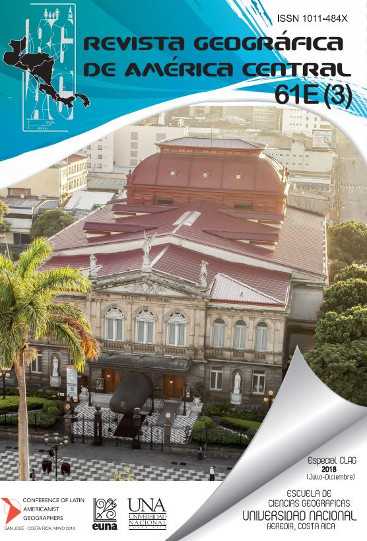Political ecology as an approach for the geographical research on ecotourism in los Tuxtlas, Mexico
DOI:
https://doi.org/10.15359/rgac.61-3.5Keywords:
ecotourism, protected natural areas, political ecology, Los Tuxtlas, Mexico.Abstract
The Los Tuxtlas region, one of the most biodiverse areas of Mexico, was declared a biosphere reserve in the year 1998. Since then, ecotourism has been promoted in the reserve, in order to promote both conservation and human development. While from an ecological point of view, it has had positive effects in some localities, ecotourism has not achieved to establish itself as an economically viable option for the local population. This limitation puts into question the sustainability of ecotourism in the area in general and inhibits that its ecological benefits could be extended further on the regional scale. In order to analyse the causes of this situation, the present investigation introduces the approach of political ecology, which allows it to analyse the role of external actors involved in multiple scales, assisting or hindering the development of ecotourism. The results are based on methods of qualitative fieldwork, particularly semi-structures interviews with local experts.
References
Brenner, L. y Hüttl, H. (2009). “Ecología Política. Un análisis geográfico de conflictos en un “medio ambiente politizado”. Presentado con base en el ejemplo de la Reserva de la Biosfera Sian Ka’an, Quintana Roo”. En: Chávez, M., González, O. M. y Ventura, M. (eds.). Geografía Humana y Ciencias Sociales: una relación reexaminada, 317-347. Zamora, México: El Colegio de Michoacán.
Brenner, L. y Job, H. (2012). “Challenges to actor-oriented Environmental Governance: examples from three Mexican biosphere reserves”. En: Tijdschrift voor Economische en Sociale Geografie, 130(1), 1-19.
Bridge, G., McCarthy, J. y Perreault, T. (eds.) (2015). The Routledge Handbook of political ecology. Abingdon , Reino Unido: Routledge.
Cohan, S. (2007). La organización social del turismo en la Reserva de la Biosfera de la Mariposa Monarca: el caso de los ejidos El Rosario y Cerro Prieto, Michoacán. Tesis de maestría. Posgrado en Geografía, Universidad Nacional Autónoma de México. México.
CONANP (2006). Programa de Conservación y Manejo: Reserva de la Biosfera Los Tuxtlas. Ciudad de México, México: Comisión Nacional de Áreas Naturales Protegidas.
CONANP (2015). Qué hacemos: áreas protegidas decretadas. Comisión Nacional de Áreas Naturales Protegidas. Recuperado: http://www.conanp.gob.mx/que_hacemos/ (20 de septiembre de 2015).
de la Maza, J., Carabias, J., Ruiz, L., Mastretta, A. y Valdez, V. (2015). Ecoturismo para la conservación: Bases para el desarrollo ecoturístico en el municipio Marqués de Comillas, Selva Lacandona, Chiapas. Ciudad de México, México: Natura y Ecosistemas Mexicanos, A.C.
Díaz-Carrión, I. A. y Neger, C. (2014). “Ecotourism in the Reserva de la Biosfera de Los Tuxtlas (Veracruz, Mexico)”. En: Athens Journal of Tourism, 1 (3), 191-202.
Gregory, D., Johnston, R., Pratt, G., Watts, M. J. y Whatmore, S. (eds.) (2009). The dictionary of Human Geography. 5a edición. Chichester, Reino Unido: Wiley-Blackwell.
Guevara, S., Laborde, J. y Sánchez-Ríos, G. (eds.) (2004). Los Tuxtlas: el paisaje de la Sierra. Xalapa, México: Instituto de Ecología.
Guzmán, M., Figueroa, F. y Durand, L. (2013). „Ecología política y ecoturismo en México: reflexiones desde la Huasteca Potosina y la Selva Lacandona”. En: Guzmán, M. y Juárez, D. (eds.). En busca del ecoturismo. Casos y experiencias del turismo sustentable en México, Costa Rica, Brasil y Australia, 29-57. San Luis, México: El Colegio de San Luis.
Honey, M. (2008). Ecotourism and sustainable development: Who owns paradise? 2a edición. Washington, D.C., Estados Unidos: Island Press.
INEGI (2012). Censo de Población y Vivienda 2010, Resultados sobre infraestructura y características socioeconómicas de las localidades con menos de 5 mil habitantes. Recuperado: http://www.beta.inegi.org.mx/proyectos/ccpv/2010/ (12 de diciembre de 2017).
INEGI (2017). Conjunto de datos vectoriales de información topográfica escala 1:50 000 serie III. Aguascalientes, México: Instituto Nacional de Estadística y Geografía.
Krings, T. (2008). “Politische Ökologie. Grundlagen und Arbeitsfelder eines geographischen Ansatzes der Mensch-Umwelt-Forschung”. En: Geographische Rundschau, 60(12), 4-9.
Liu, Z. H. (2003). “Sustainable tourism development: A critique”. En: Journal of Sustainable Tourism, 11(6), 459-475.
López, G. y Palomino, B. (2012). Guía de apoyos federales para el desarrollo del turismo de naturaleza en México. Ciudad de México, México: Instituto de Competitividad Turística, Consejo Nacional de Ciencia y Tecnología.
OMT y PNUMA (2002). World Ecotourism Summit: Final report. Madrid: Organización Mundial del Turismo.
Robbins, P. (2012). Political Ecology: a critical introduction. 2a edición. Chichester, Reino Unido: Wiley-Blackwell.
SECTUR, CESTUR y UAM (2007). Elementos para Evaluar el Impacto Económico, Social y Ambiental del Turismo de Naturaleza en México. Ciudad de México, México: Secretaría de Turismo.
Weaver, D. (2006). Sustainable Tourism: Theory and Practice. Oxford, Reino Unido: Elsevier Butterworth-Heinemann.
Downloads
Published
How to Cite
Issue
Section
License
Proposed policy for journals offering Open Access
Authors publishing their works in the Journal acknowledge and agree to the following terms:
a) Authors retain the copyrights to their works and guarantee the Journal the right to be the first to publish their works, under the Creative Commons License Attribution-NonCommercial-ShareAlike 4.0 International, CC BY-NC-SA 4.0 International (https://creativecommons.org/licenses/by-nc-sa/4.0/deed.es), which allows others to share works upon complying with the acknowledgment of authorship and mention of the Journal as the original publisher of the work.
b) Authors are permitted to separately establish additional agreements for the non-exclusive distribution of the official edition of the work published in the Journal (for example, authors may desire to place the work in an institutional repository or incorporate it into a book that is to published elsewhere) so long they acknowledgment to recognize the Journal as the original publisher. The aforementioned additional agreements must respect the terms of the non-profit character and sharing philosophy of the original license (CC BY-NC-SA 4.0 International, https://creativecommons.org/licenses/by-nc-sa/4.0/deed.es).
c) Authors are encouraged to archive the post-print or editor/PDF version in Open Access repositories.






 REVGEO is licensed under https://creativecommons.org/licenses/by-nc-sa/4.0/deed.es
REVGEO is licensed under https://creativecommons.org/licenses/by-nc-sa/4.0/deed.es
.svg_4.png)

_(1).png)
_(1)_(1)_(1)_1.png)
(2)(1)(1)(1).png)
